I. Religious Liberty Issues
Religiously based Refusals to Serve Gay, Lesbian People
Nearly two-thirds (64%) of Americans oppose allowing small business owners in their state to refuse to provide products or services to gay or lesbian people if doing so violates their religious beliefs. Roughly one-third (32%) support such religiously based service refusals.
A majority (52%) of Republicans believe small business owners should be allowed to refuse products or services to gay and lesbian people if doing so conflicts with their religious beliefs; fewer than one-third of political independents (31%) and Democrats (16%) agree. More than eight in ten (81%) Democrats and about two-thirds (66%) of independents say small businesses should not be allowed to refuse to do business with gay and lesbian people on religious grounds.
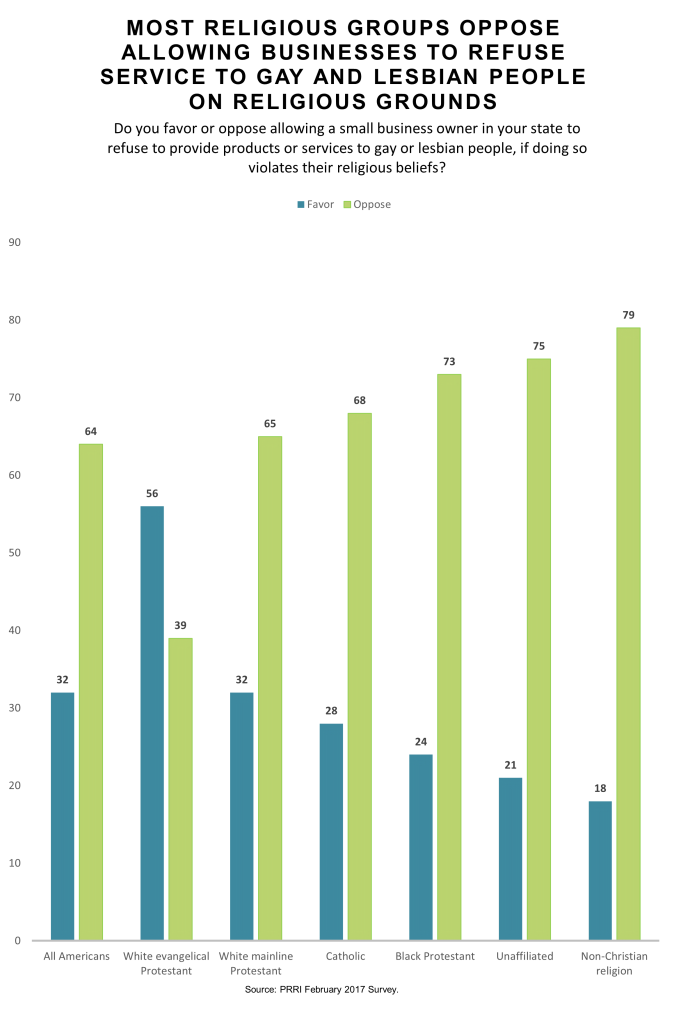 White evangelical Protestants (56%) stand out as the only major religious group that favors allowing small business owners to refuse goods or services to gay and lesbian people on religious grounds. Fewer than one-third of white mainline Protestants (32%), Catholics (28%), black Protestants (24%), religiously unaffiliated Americans (21%), and members of non-Christian traditions (18%) support a religious exemption for small business owners. Notably, despite opposition to same-sex marriage, more than seven in ten (73%) black Protestants oppose allowing small business owners to refuse service to gay and lesbian people.
White evangelical Protestants (56%) stand out as the only major religious group that favors allowing small business owners to refuse goods or services to gay and lesbian people on religious grounds. Fewer than one-third of white mainline Protestants (32%), Catholics (28%), black Protestants (24%), religiously unaffiliated Americans (21%), and members of non-Christian traditions (18%) support a religious exemption for small business owners. Notably, despite opposition to same-sex marriage, more than seven in ten (73%) black Protestants oppose allowing small business owners to refuse service to gay and lesbian people.
Contraception Mandate
Two-thirds (67%) of the public favor requiring employers to provide employees with health care plans that cover contraception or birth control at no cost. Fewer than one-third (30%) oppose this idea.
More than eight in ten (84%) Democrats and two-thirds (67%) of political independents support requiring employers to include contraception coverage in their employee health care plans. Republicans are divided: 48% favor this requirement while half (50%) are opposed.
Attitudes also diverge sharply by generation. Eight in ten (80%) young adults (age 18-29) support a policy that would require employers to offer health care plans that cover contraception at no additional cost. A majority (54%) of seniors (ages 65 and older) also agree, but a sizable minority (41%) oppose such a policy. There is also a sizeable gender gap among seniors. Nearly six in ten (58%) senior women, but only 49% of senior men, support a contraception requirement in employer health care plans.
Should Churches be Allowed to Endorse Political Candidates?
More than seven in ten (71%) Americans oppose allowing churches and places of worship to endorse political candidates while retaining their tax-exempt status, compared to only 22% who favor such a policy.
There are only modest differences between partisans and among religious groups. Republicans are more than twice as likely as Democrats to favor allowing churches to endorse candidates (34% vs. 16%, respectively). However, strong majorities of Republicans (62%) and Democrats (78%) reject this idea.
All major religious groups in the country oppose allowing churches to endorse candidates while retaining their tax-exempt status. Only about one-third (36%) of white evangelical Protestants favor allowing churches to endorse candidates, compared to a majority (56%) who oppose it. Even fewer white mainline Protestants (23%), Catholics (25%), black Protestants (19%), and religiously unaffiliated Americans (12%) support churches endorsing political candidates.
II. LGBT Policy
Same-sex Marriage
After plateauing in 2015, support for same-sex marriage has accelerated through 2016 and into early 2017. Today, more than six in ten (63%) favor allowing gay and lesbian couples to marry legally. As recently as 2013, only slightly more than half (52%) the public backed same-sex marriage nationally.¹
Support for same-sex marriage is fairly consistent across regions with one notable exception: Americans living in the South are substantially less supportive than Americans living in other parts of the country. Roughly seven in ten Americans living in the Northeast (69%), West (68%) and Midwest (67%) favor same-sex marriage compared to 54% of Southerners.
Same-sex marriage is now supported by more than three-quarters of Democrats (76%) and roughly two-thirds (66%) of independents. Fewer than half (45%) of Republicans favor same-sex marriage, but only a slim majority (51%) still oppose it. Like Americans overall, Republicans are divided by age. A majority (57%) of Republicans under the age of 50 favor same-sex marriage, compared to only about one-third (36%) of those aged 50 or older.
Same-sex marriage now garners majority support among most religious groups. Roughly two-thirds of white mainline Protestants (66%) and Catholics (68%), and more than eight in ten (84%) religiously unaffiliated Americans and members of non-Christian religious traditions (86%) favor allowing gay and lesbian couples to marry legally. In stark contrast, only about one-third (34%) of white evangelical Protestants and roughly half (47%) of black Protestants support same-sex marriage.
LGBT Nondiscrimination Laws
There is broad public support for laws protecting gay, lesbian, bisexual and transgender people against discrimination in jobs, public accommodations and housing. Seven in ten (70%) Americans favor laws that would provide these protections to LGBT people, compared to roughly one-quarter (26%) who oppose such laws.
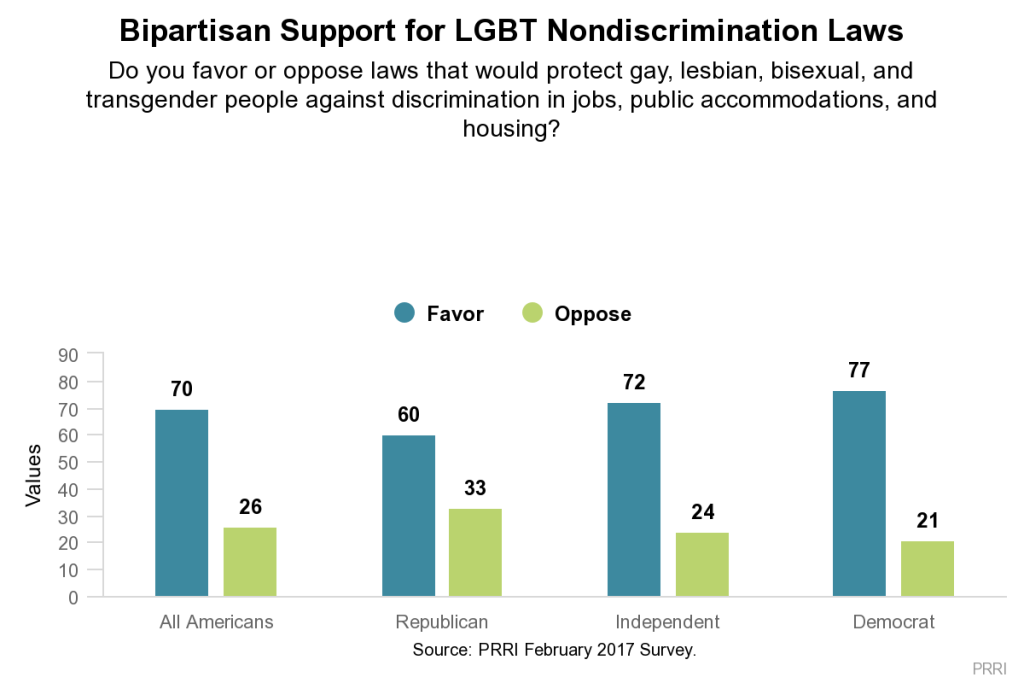 Support for nondiscrimination laws cuts across party lines, although there are substantial differences in the degree of support. Nearly eight in ten Democrats (77%), more than seven in ten (72%) independents, and six in ten Republicans (60%) favor laws protecting LGBT people from discrimination in jobs, public accommodations, and housing.
Support for nondiscrimination laws cuts across party lines, although there are substantial differences in the degree of support. Nearly eight in ten Democrats (77%), more than seven in ten (72%) independents, and six in ten Republicans (60%) favor laws protecting LGBT people from discrimination in jobs, public accommodations, and housing.
Majorities of all major religious groups favor nondiscrimination laws for LGBT people. More than six in ten white mainline Protestants (63%), seven in ten Catholics (70%) and roughly eight in ten religiously unaffiliated Americans (79%) favor LGBT nondiscrimination laws. Even among white evangelical Protestants—the religious group that most strongly opposes same-sex marriage—a majority (56%) support laws protecting LGBT people from discrimination.
Transgender Bathroom Laws
A majority (53%) of Americans oppose laws that would require transgender people to use bathrooms that correspond to their sex at birth rather than their current gender identity. Nearly four in ten (39%) favor such laws. Notably, nearly one in ten (8%) Americans report no opinion on this issue.
A majority of independents (57%) and nearly two-thirds (65%) of Democrats oppose requiring transgender people to use bathrooms of their birth sex as opposed to their current gender identity. In contrast, most Republicans (59%) favor requiring transgender people to use bathrooms that correspond to their sex at birth, while fewer than four in ten independents (39%) and Democrats (30%) agree.
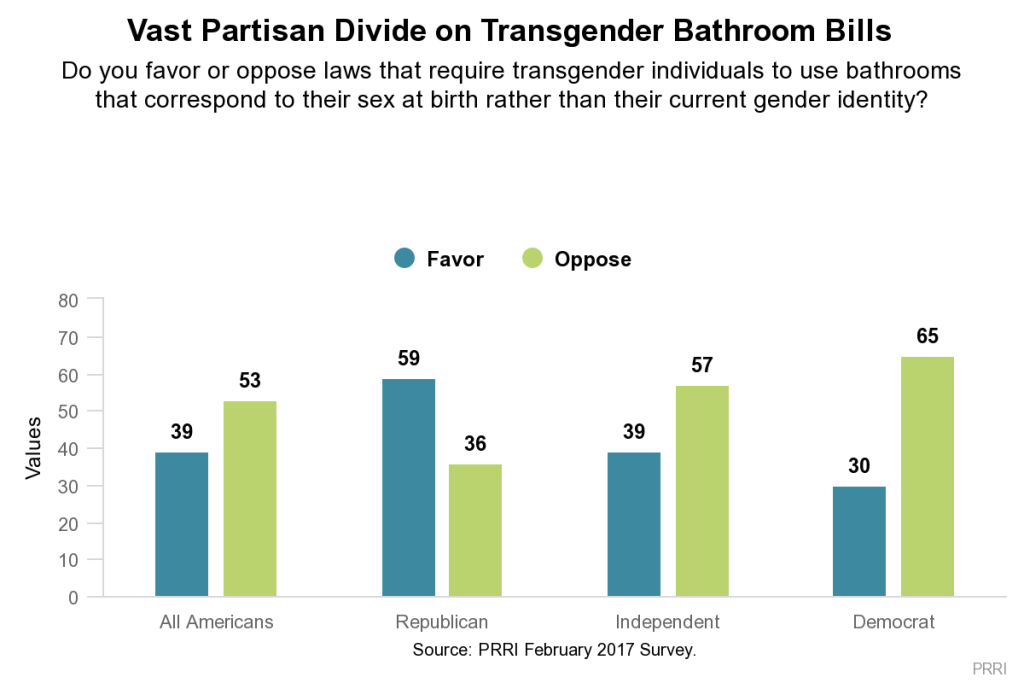 Religious divisions are less stark. A majority of religiously unaffiliated Americans (64%) and Catholics (56%) oppose laws that require transgender people to use bathrooms that align with their sex at birth. Other religious groups are more divided. Half (50%) of white evangelical Protestants and close to half (45%) of nonwhite Protestants favor laws mandating that transgender people use bathrooms corresponding to their birth sex. Roughly as many white evangelical Protestants (45%) and nonwhite Protestants (45%) oppose such laws. Four in ten (40%) white mainline Protestants favor transgender bathroom laws, while half (50%) are opposed. More than one in ten (11%) white mainline Protestants offer no opinion.
Religious divisions are less stark. A majority of religiously unaffiliated Americans (64%) and Catholics (56%) oppose laws that require transgender people to use bathrooms that align with their sex at birth. Other religious groups are more divided. Half (50%) of white evangelical Protestants and close to half (45%) of nonwhite Protestants favor laws mandating that transgender people use bathrooms corresponding to their birth sex. Roughly as many white evangelical Protestants (45%) and nonwhite Protestants (45%) oppose such laws. Four in ten (40%) white mainline Protestants favor transgender bathroom laws, while half (50%) are opposed. More than one in ten (11%) white mainline Protestants offer no opinion.
III. Discrimination in America
Bullying of LGBT Teens
Nearly two-thirds (65%) of Americans agree that the bullying of gay, lesbian, bisexual, and transgender teens is a major problem in our schools, compared to fewer than three in ten (29%) who disagree. Concern is widespread across all segments of society.
Although there is agreement across party lines, the degree of concern varies. Fully three-quarters (75%) of Democrats and about two-thirds (66%) of independents believe the bullying of LGBT teens is a major problem in America’s schools. A majority (55%) of Republicans also say this is a problem, although a significant minority (39%) disagree.
Nearly three-quarters (74%) of religiously unaffiliated Americans and nearly seven in ten (69%) nonwhite Protestants say the bullying of LGBT teens is a major problem in our schools. A majority of white mainline Protestants (62%), white evangelical Protestants (56%), and white Catholics (55%) also cite school bullying of LGBT teens as a major problem.
Discrimination Against Gay and Lesbian, Transgender People
More than six in ten Americans say gay and lesbian people (61%) and transgender people (64%) face a lot of discrimination in the U.S. today.
However, there are sharp partisan differences on this question. Democrats are roughly twice as likely as Republicans to say gay and lesbian people face a lot of discrimination in the country today (79% vs. 40%, respectively). Notably, a majority (57%) of Republicans do not believe gay and lesbian people face a lot of discrimination. Independents largely reflect the views of the public overall. An identical number (79%) of Democrats believe transgender people face a lot of discrimination, while fewer than half (48%) of Republicans agree. Again, the views of independents generally align with Americans overall.
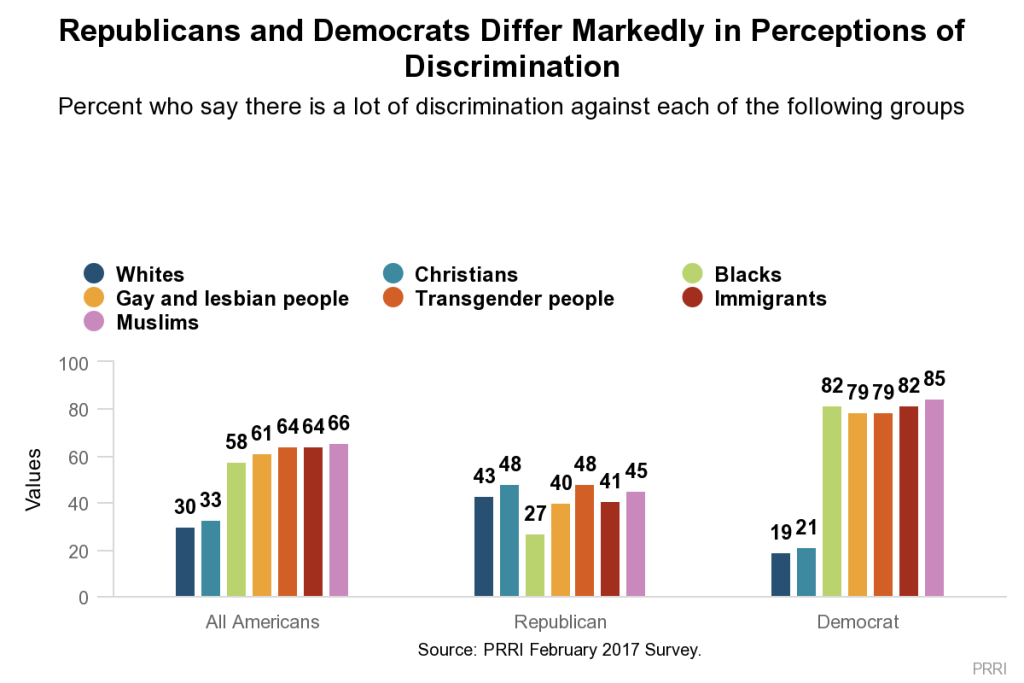 Opinion is also fractured along religious lines, with white Christian groups expressing views that are quite different from most other religious groups. White evangelical Protestants stand out as the only group in which less than a majority (46%) believe gay and lesbian people face a lot of discrimination today. Majorities of white mainline Protestants (52%) and white Catholics (54%) and at least seven in ten nonwhite Protestants (70%), members of non-Christian religious traditions (70%), and unaffiliated Americans (73%) say gay and lesbian people experience a great deal of discrimination in the U.S. today. Opinions about discrimination faced by transgender people follows a similar pattern.
Opinion is also fractured along religious lines, with white Christian groups expressing views that are quite different from most other religious groups. White evangelical Protestants stand out as the only group in which less than a majority (46%) believe gay and lesbian people face a lot of discrimination today. Majorities of white mainline Protestants (52%) and white Catholics (54%) and at least seven in ten nonwhite Protestants (70%), members of non-Christian religious traditions (70%), and unaffiliated Americans (73%) say gay and lesbian people experience a great deal of discrimination in the U.S. today. Opinions about discrimination faced by transgender people follows a similar pattern.
Discrimination Against Whites vs. Blacks
Nearly six in ten (58%) Americans say blacks face a lot of discrimination in American society today, while only three in ten (30%) say the same of whites. More Americans now say blacks face a considerable degree of discrimination in U.S. society than in 2013 when slightly more than half (52%) of the public expressed this view.²
Racial, ethnic, and class divides on this issue follow expected patterns. Nearly nine in ten (87%) black Americans say black people face a lot discrimination, but only 19% say the same is true of whites. Approximately half (49%) of whites say blacks face discrimination, while just over one-third (34%) say the same of whites. Class divisions among whites are notable. While whites with a college degree mirror the population overall, whites without a college degree are about equally as likely to believe that blacks (44%) and whites (39%) face a great deal of discrimination. Hispanics do not differ substantially from the general population on this issue.
Notably, Republicans are significantly more likely to say that whites, rather than blacks, experience a lot of discrimination in the U.S. today (43% vs. 27%, respectively). Democrats and independents are far more likely to say blacks experience a lot of discrimination than to say the same about whites (82% vs. 19% and 59% vs. 30%, respectively). The partisan gap in perceptions of discrimination against blacks has increased substantially over the last four years, driven primarily by shifts among Democrats. In 2013, about two-thirds (66%) of Democrats compared to roughly one-third (32%) of Republicans expressed the view that discrimination against blacks in the U.S. is common. Notably, white and nonwhite Democrats recorded nearly identical changes in opinion.
Discrimination Against Christians vs. Muslims
A similar pattern emerges in views of the relative amount of discrimination faced by Muslims and Christians in American society. Americans are twice as likely to say Muslims face a lot of discrimination as to say the same of Christians (66% vs. 33%, respectively). Again, there are sizable differences by party affiliation, religious background, and generation.
Democrats are more than four times as likely to say Muslims (85%) face a lot of discrimination as to say the same of Christians (21%). Republicans, in contrast, are about equally as likely to say both Christians (48%) and Muslims (45%) experience a lot of discrimination in the US today. Independents’ attitudes mirror those of Americans overall.
Religious differences are also striking, with white evangelical Protestants standing out from other religious Americans. White evangelicals are more likely to say Christians face a lot of discrimination than they are to say Muslims face a lot of discrimination (57% vs. 44%, respectively). White evangelicals are the only major religious group in which a majority say Christians face a lot of discrimination. In contrast, roughly three-quarters of religiously unaffiliated Americans (77%) and nonwhite Protestants (75%), and more than six in ten white Catholics (64%) and white mainline Protestants (63%) agree Muslims face a lot of discrimination. Fewer than half of nonwhite Protestants (40%), white mainline Protestants (30%), white Catholics (26%) and religiously unaffiliated Americans (23%) say Christians experience a lot of discrimination.
 Generational divisions are stark in perceptions of discrimination faced by Muslims, but less so in views about the amount of discriminations confronting Christians. More than three-quarters (77%) of young adults say that Muslims face a lot of discrimination compared to only about half (51%) of seniors. Notably, similar numbers of young adults (25%) and seniors (32%) say Christians are experiencing a great amount of discrimination.
Generational divisions are stark in perceptions of discrimination faced by Muslims, but less so in views about the amount of discriminations confronting Christians. More than three-quarters (77%) of young adults say that Muslims face a lot of discrimination compared to only about half (51%) of seniors. Notably, similar numbers of young adults (25%) and seniors (32%) say Christians are experiencing a great amount of discrimination.
Discrimination Against Immigrants
Nearly two-thirds (64%) of Americans say immigrants face a lot of discrimination in the U.S. today, while one-third (33%) believe they do not. Americans are sharply divided by party and generation.
Democrats are twice as likely as Republicans to say immigrants face a substantial degree of discrimination in society (82% vs. 41%, respectively). Roughly two-thirds (65%) of independents also believe immigrants confront a great deal of discrimination.
Young adults are more likely to perceive discrimination against immigrants than older Americans. More than three-quarters (77%) of young adults, compared to slightly more than half (53%) of seniors, say immigrants are contending with a lot of discrimination in the U.S. today.
IV. Religion and Morality
Are Religious Groups Alienating Young People?
Americans are closely divided over whether faith groups are driving away younger Americans because of intolerant views of gay and lesbian people. Half (50%) of Americans agree religious groups are alienating young people by being too judgmental about gay and lesbian issues, while nearly as many (45%) disagree. Current views of the public represent a significant departure from 2013, when nearly six in ten (58%) Americans said religious groups were alienating young people over gay and lesbian issues.³
There is considerable disagreement among religious groups about the degree to which houses of worship are alienating young adults. Nearly two-thirds (65%) of religiously unaffiliated Americans and slim majorities of white mainline Protestants (51%) and white Catholics (51%) believe religious groups’ judgmental attitudes about the gay and lesbian community are souring young people to religion. Fewer than four in ten nonwhite Protestants (38%) and white evangelical Protestants (33%) agree. A majority of both white evangelical Protestants (63%) and nonwhite Protestants (56%) disagree that churches are alienating young people over their teachings about gay and lesbian issues and people.
There is significant disagreement among Americans across the partisan divide in views about whether houses of worship are repelling young adults. More than six in ten (62%) Democrats agree that judgmental attitudes about the gay and lesbian community are driving young people away from the pews, while fewer than four in ten (38%) Republicans say the same. Six in ten (60%) Republicans disagree. Political independents—like the public overall—are almost evenly divided (48% agree, 46% disagree).
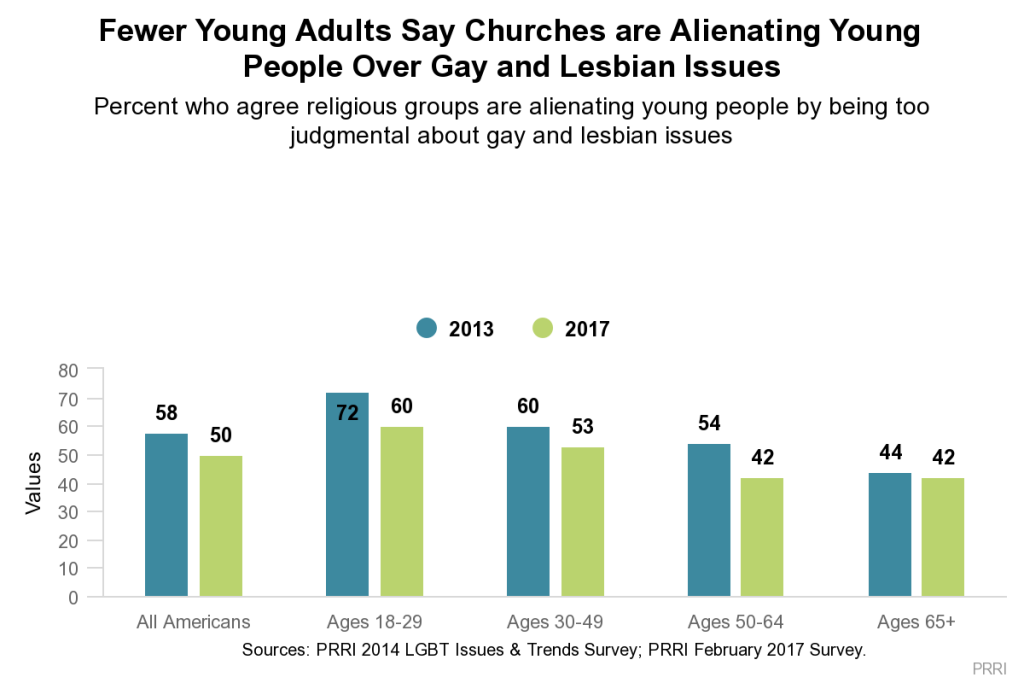 Young adults are substantially more likely than older Americans to say religious groups are driving young people away by being too judgmental about gay and lesbian issues. Six in ten (60%) young adults say negative views about gays and lesbians coming from places of worship are alienating young people, while fewer than half (42%) of seniors agree. However, no group shifted their position more significantly than young adults—in 2013 more than seven in ten (72%) said religious groups were alienating young people.
Young adults are substantially more likely than older Americans to say religious groups are driving young people away by being too judgmental about gay and lesbian issues. Six in ten (60%) young adults say negative views about gays and lesbians coming from places of worship are alienating young people, while fewer than half (42%) of seniors agree. However, no group shifted their position more significantly than young adults—in 2013 more than seven in ten (72%) said religious groups were alienating young people.
The Morality of Sex Outside Heterosexual Marriages
Americans are evenly divided about whether sex can be considered moral when it takes place outside of a heterosexual marriage. Nearly half (48%) of Americans agree sex is only morally acceptable if it is between a married man and woman, while a nearly identical number (49%) disagree.
There is considerable partisan disagreement over when sex can be considered morally acceptable. Seven in ten (70%) Republicans say sex can only be considered morally acceptable when it takes place between a married heterosexual couple, but only four in ten independents (42%) and Democrats (39%) say the same. A majority of Democrats (58%) and independents (55%) disagree.
By a wide margin, white evangelical Protestants are most likely to say sex is only morally permissible when it occurs within the confines of marriage between a man and a woman. More than eight in ten (83%) white evangelical Protestants agree sex is only moral when it is between a married heterosexual couple, as do more than six in ten (63%) nonwhite Protestants. Just under half of Catholics (46%), four in ten (40%) white mainline Protestants and fewer than one in four (23%) religiously unaffiliated Americans agree.
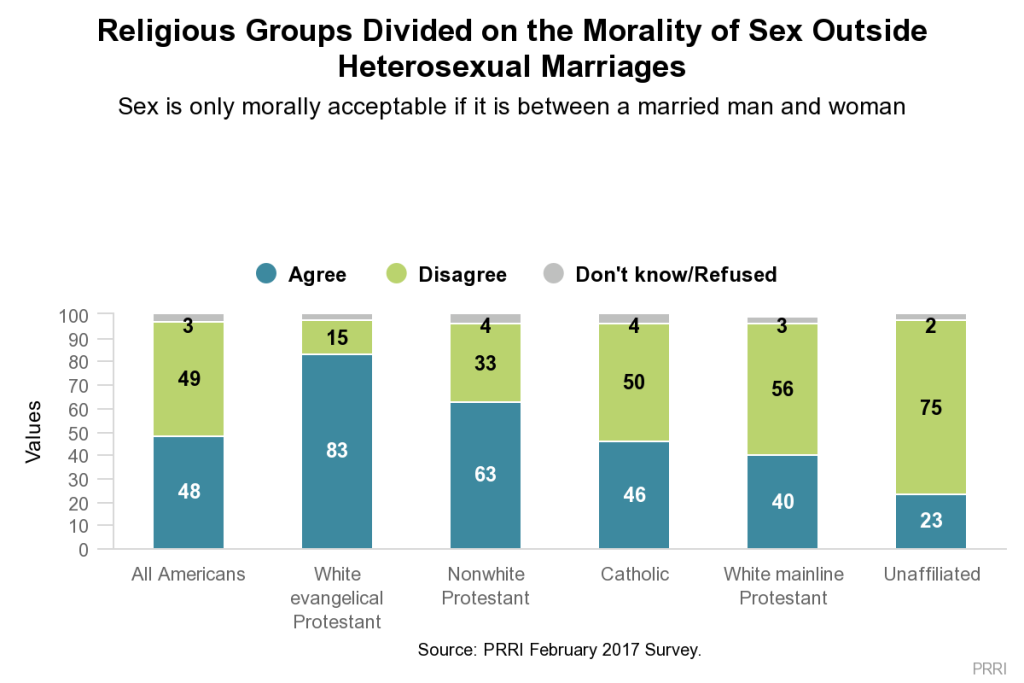 Unsurprisingly, young adults express a much less restrictive view about the morality of sex. While nearly two-thirds (64%) of seniors agree sex is only moral when it is between a married man and woman, only three in ten (30%) young adults say the same. Nearly seven in ten (69%) young adults disagree that sex is only morally acceptable when it takes place within a heterosexual marriage.
Unsurprisingly, young adults express a much less restrictive view about the morality of sex. While nearly two-thirds (64%) of seniors agree sex is only moral when it is between a married man and woman, only three in ten (30%) young adults say the same. Nearly seven in ten (69%) young adults disagree that sex is only morally acceptable when it takes place within a heterosexual marriage.
V. The Shifting Social Context
Gay and Lesbian Friends and Family
The number of Americans who report having close friends or family members who are gay, lesbian, or transgender continues to grow. Seven in ten (70%) Americans now say they have a close friend or family member who identifies as gay or lesbian, compared to 58% in 2011.4
Democrats and independents are now only somewhat more likely to report having a close friend or family member who is gay than Republicans, a shift from six years earlier. Three-quarters (75%) of Democrats and seven in ten (70%) independents say they have a close friend or family member who is gay compared to more than six in ten (63%) Republicans. In 2011, more than two-thirds (68%) of Democrats but fewer than half (46%) of Republicans said they had a close friend or family member who is gay.
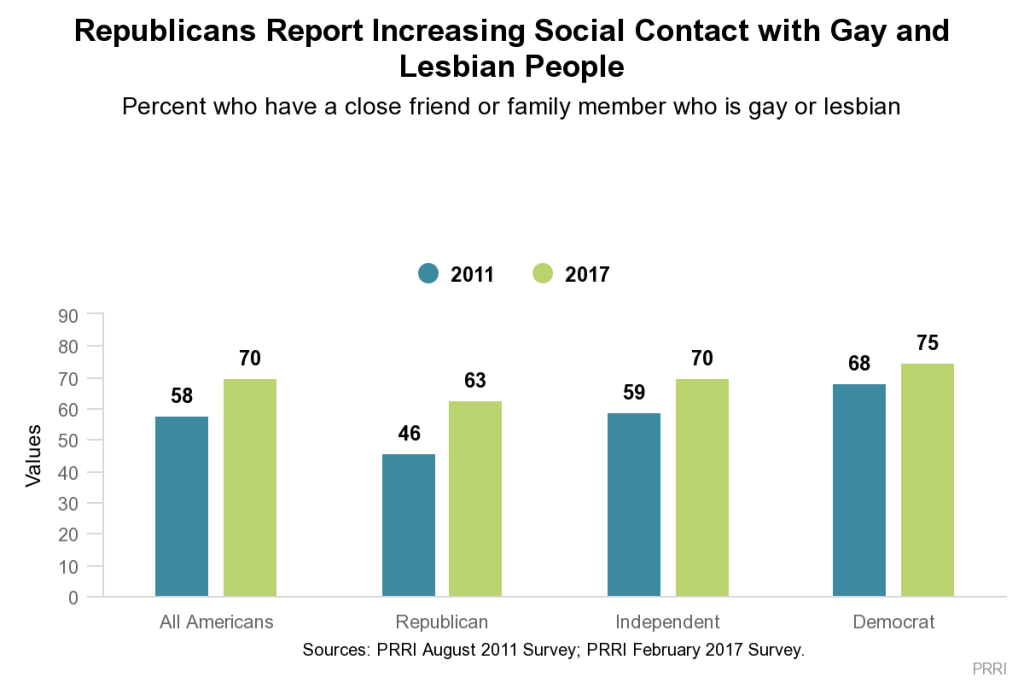 Americans without a religious affiliation are the most likely to have a close friend or family member who is gay or lesbian, although majorities of every religious group report having a gay or lesbian person in their social network. More than eight in ten (82%) religiously unaffiliated Americans have a close friend or family member who is gay or lesbian, as do about seven in ten white mainline Protestants (73%) and white Catholics (70%). Nearly two-thirds (65%) of nonwhite Protestants and a majority (53%) of white evangelical Protestants also report having a close social connection to someone who is gay or lesbian.
Americans without a religious affiliation are the most likely to have a close friend or family member who is gay or lesbian, although majorities of every religious group report having a gay or lesbian person in their social network. More than eight in ten (82%) religiously unaffiliated Americans have a close friend or family member who is gay or lesbian, as do about seven in ten white mainline Protestants (73%) and white Catholics (70%). Nearly two-thirds (65%) of nonwhite Protestants and a majority (53%) of white evangelical Protestants also report having a close social connection to someone who is gay or lesbian.
Young adults are significantly more likely than older Americans to report a close connection to someone who is gay or lesbian. More than eight in ten (81%) young adults (age 18-29) have a close friend or family member who is part of the gay or lesbian community, compared to 54% of seniors (age 65 and older).
Transgender Friends and Family
Today, more than one in five (21%) Americans report having a close friend or family member who is transgender, nearly double (11%) the number who reported having such a connection in 2011.
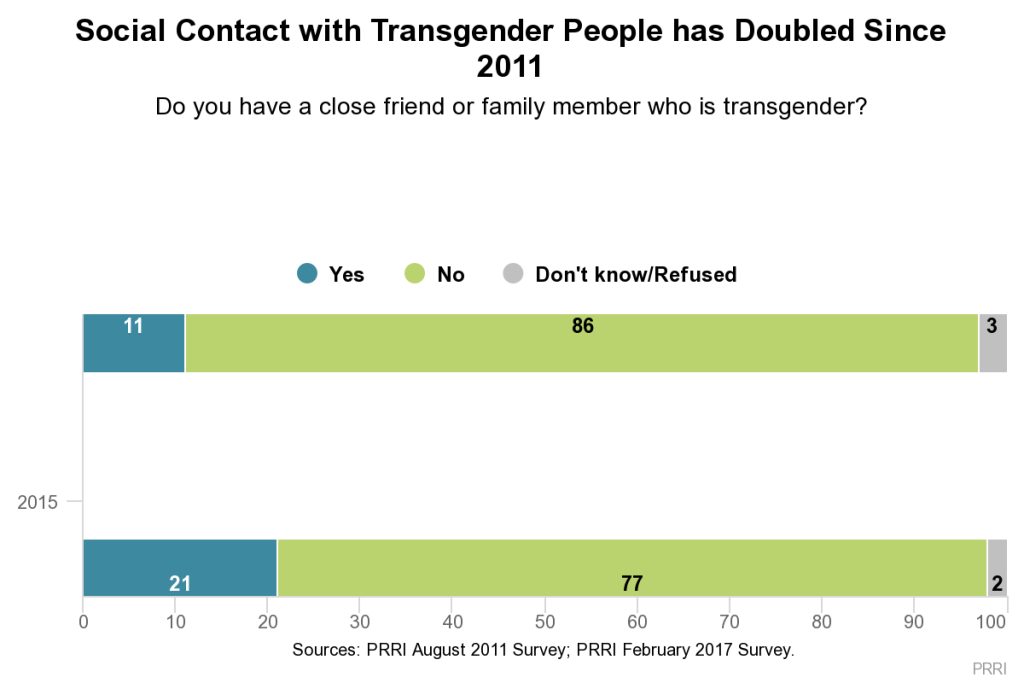 The increase in social contact with the transgender community has largely been driven by younger Americans. Younger Americans (age 18 to 34) are 10 percentage points more likely to report having a transgender family member or close friend today compared to 2011 (28% vs. 18%, respectively). Seniors (age 65 and older) report almost no change in social contact with transgender individuals as compared to six years ago (9% vs. 8%, respectively).
The increase in social contact with the transgender community has largely been driven by younger Americans. Younger Americans (age 18 to 34) are 10 percentage points more likely to report having a transgender family member or close friend today compared to 2011 (28% vs. 18%, respectively). Seniors (age 65 and older) report almost no change in social contact with transgender individuals as compared to six years ago (9% vs. 8%, respectively).
Independents (27%) and Democrats (22%) are considerably more likely than Republicans (11%) to report having a close friend or family member who is transgender.
Americans without a religious affiliation are more likely than their religiously affiliated counterparts to have a close social connection to a transgender person. Roughly three in ten (29%) religiously unaffiliated Americans report having a close friend or family member who is transgender, compared to one in five (20%) nonwhite Protestants and 15% of white mainline Protestants. Thirteen percent of white Catholics and just nine percent of white evangelical Protestants have a transgender family member or close friend.
Rising Knowledge about the Transgender Issue
In addition to growing social contact with transgender people, Americans report an increased understanding of the meaning of transgender. Today, more than eight in ten (84%) Americans say they know what the term transgender means. In 2011, seven in ten (70%) said they fully understood the term transgender, while roughly one-quarter (24%) knew the term but not what it meant and another 5% had never heard the term before.5
Knowledge about the term transgender varies only modestly by age. Nearly nine in ten (87%) young adults (age 18-29) say they know what the term transgender means, compared to about three-quarters (76%) of seniors (age 65 and older).
Familiarity with the term is increasing fastest among older Americans. Despite continuing low levels of contact with transgender people, seniors are nearly 20 percentage points more likely to report familiarity with the term transgender today than they were in 2011 (76% vs. 58%, respectively). Americans under the age of 65, in comparison, have a 13 percentage-point increase in understanding of the word transgender as compared to six years ago (86% vs. 73%, respectively).
Endnotes
1 PRRI 2013 American Values Survey.
2 PRRI 2014 LGBT Issues & Trends Survey.
3 Ibid.
4 PRRI August 2011 Survey.
5 When asked to define the term “transgender” in an open-ended follow-up question, most (76%) Americans were able to provide a correct answer. Source: PRRI September 2011 Survey.
Recommended Citation
Jones, Robert P., Daniel Cox, Betsy Cooper, and Rachel Lienesch. “Majority of Americans Oppose Transgender Bathroom Restrictions.” PRRI. 2017. http://www.prri.org/research/lgbt-transgender-bathroom-discrimination-religious-liberty/


